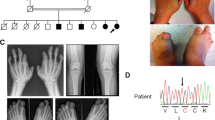Abstract
Acromesomelic dysplasia, Grebe type is a very rare skeletal dysplasia characterized by severe dwarfism with marked micromelia and deformation of the upper and lower limbs, with a proximodistal gradient of severity. CDMP1 gene mutations have been associated with Grebe syndrome, Hunter–Thompson syndrome, Du Pan syndrome and brachydactyly type C. The proband is a 4-year-old boy, born of consanguineous Pakistani parents. Radiographic imaging revealed features typical of Grebe syndrome: severe shortening of the forearms with an acromesomelic pattern following a proximodistal gradient, with distal parts more severely affected than medial parts; hypoplastic hands, with the phalangeal zone more affected than the metacarpal zone; and severe hypoplastic tibial/femoral zones in both limbs. After molecular analyses, the p.Arg377Trp variant in a homozygous pattern was identified in the CDMP1 gene in the affected child. In silico and structural analyses predicted the p.Arg377Trp amino acid change to be pathogenic. Of the 34 mutations described in the CDMP1 gene, four different missense mutations have been associated with Grebe syndrome. The CDMP1 gene encodes growth differentiation factor 5 (GDF5), which plays a role in regulation of limb patterning, joint formation and distal bone growth. Homozygous mutations in the mature domain of GDF5 result in severe limb malformations such as the Grebe type or the Hunter–Thompson type of acromesomelic chondrodysplasia. The p.Arg377Trp mutation is located within the recognition motif at the processing site of GDF5 where the sequence RRKRR changes to WRKRR. The genotype–phenotype correlation allowed not only confirmation of the clinical diagnosis but also appropriate genetic counselling to be offered to this family.



Similar content being viewed by others
References
Costa T, Ramsby G, Cassia F et al (1998) Grebe syndrome: clinical and radiographic findings in affected individuals and heterozygous carriers. Am J Med Genet 75:523–529
Thomas JT, Kilpatrick MW, Lin K et al (1997) Disruption of human limb morphogenesis by a dominant negative mutation in CDMP1. Nat Genet 17:58–64
Chang SC, Hoang B, Thomas JT et al (1994) Cartilage-derived morphogenetic proteins. New members of the transforming growth factor-beta superfamily predominantly expressed in long bones during human embryonic development. J Biol Chem 269:28227–28234
Francis-West P, Abdelfattah A, Chen P et al (1999) Mechanisms of GDF-5 action during skeletal development. Development 126:1305–1315
Basit S, Naqvi SK-H, Wasif N et al (2008) A novel insertion mutation in the cartilage-derived morphogenetic protein-1 (CDMP1) gene underlies Grebe-type chondrodysplasia in a consanguineous Pakistani family. BMC Med Genet 9:102. doi:10.1186/1471-2350-9-102
Luyten FP (1997) Cartilage-derived morphogenetic protein-1. Int J Biochem Cell Biol 29:1241–1244
Plöger F, Seemann P, Schmidt-von Kegler M et al (2008) Brachydactyly type A2 associated with a defect in proGDF5 processing. Hum Mol Genet 17:1222–1233. doi:10.1093/hmg/ddn012
Douzgou S, Lehmann K, Mingarelli R et al (2008) Compound heterozygosity for GDF5 in Du Pan type chondrodysplasia. Am J Med Genet A 146A:2116–2121. doi:10.1002/ajmg.a.32435
Rosas-Blum E, Shirsat P, Leiner M (2007) Communicating genetic information: a difficult challenge for future pediatricians. BMC Med Educ 7:17. doi:10.1186/1472-6920-7-17
Farrell MH (2001) Genetic counseling and risk communication services of newborn screening programs. Arch Pediatr Adolesc Med 155:120. doi:10.1001/archpedi.155.2.120
Acknowledgments
We thank Rosa Riveiro-Alvarez for her contribution to this work. This work was supported by the Fundación Ramon Areces (4715/001), and the author, Monica Martinez-Garcia, was supported by the Fundación Conchita Rábago de Jiménez Díaz.
Conflict of interest
The authors declare that they have no conflict of interest.
Author information
Authors and Affiliations
Corresponding author
About this article
Cite this article
Martinez-Garcia, M., Garcia-Canto, E., Fenollar-Cortes, M. et al. Characterization of an acromesomelic dysplasia, Grebe type case: novel mutation affecting the recognition motif at the processing site of GDF5. J Bone Miner Metab 34, 599–603 (2016). https://doi.org/10.1007/s00774-015-0693-z
Received:
Accepted:
Published:
Issue Date:
DOI: https://doi.org/10.1007/s00774-015-0693-z




